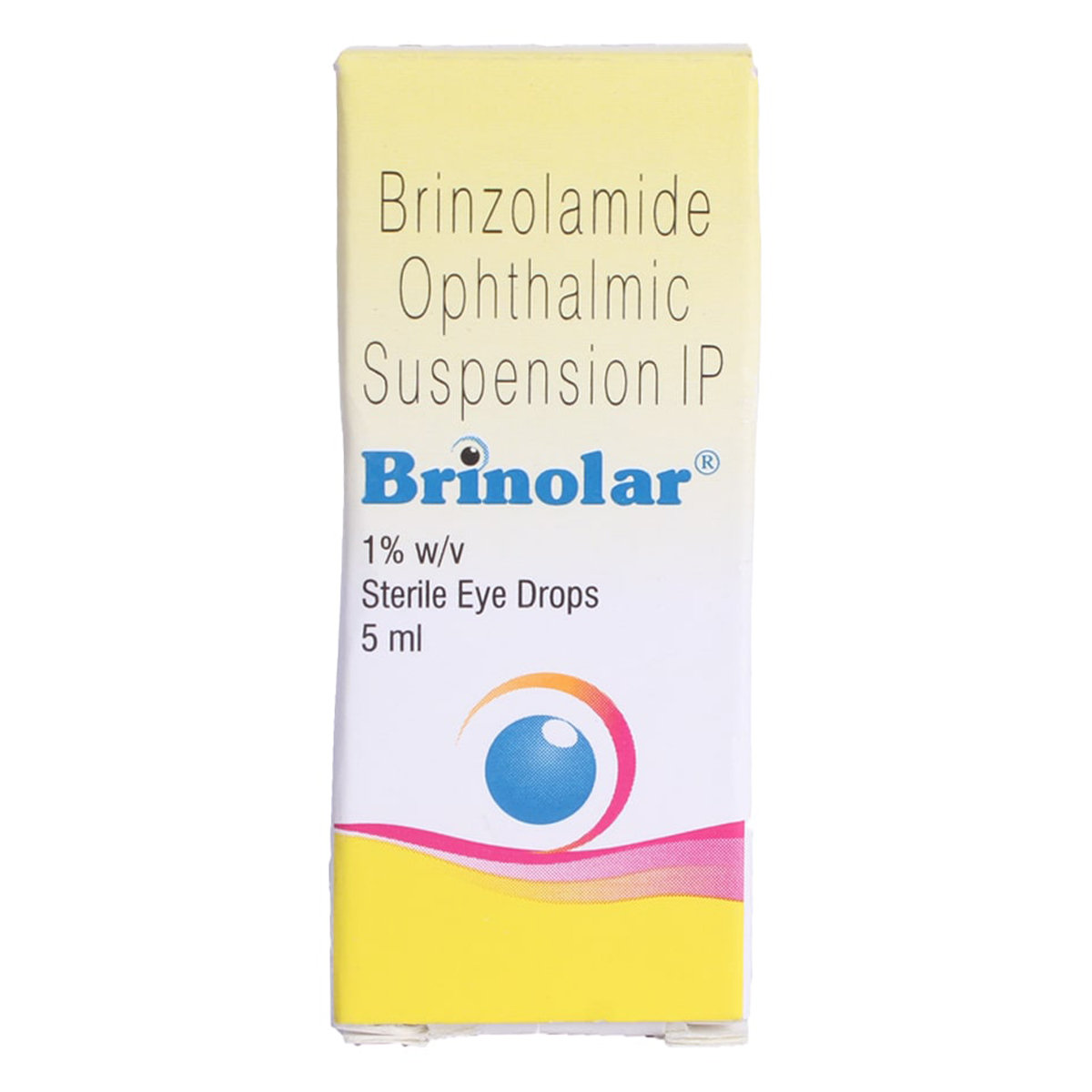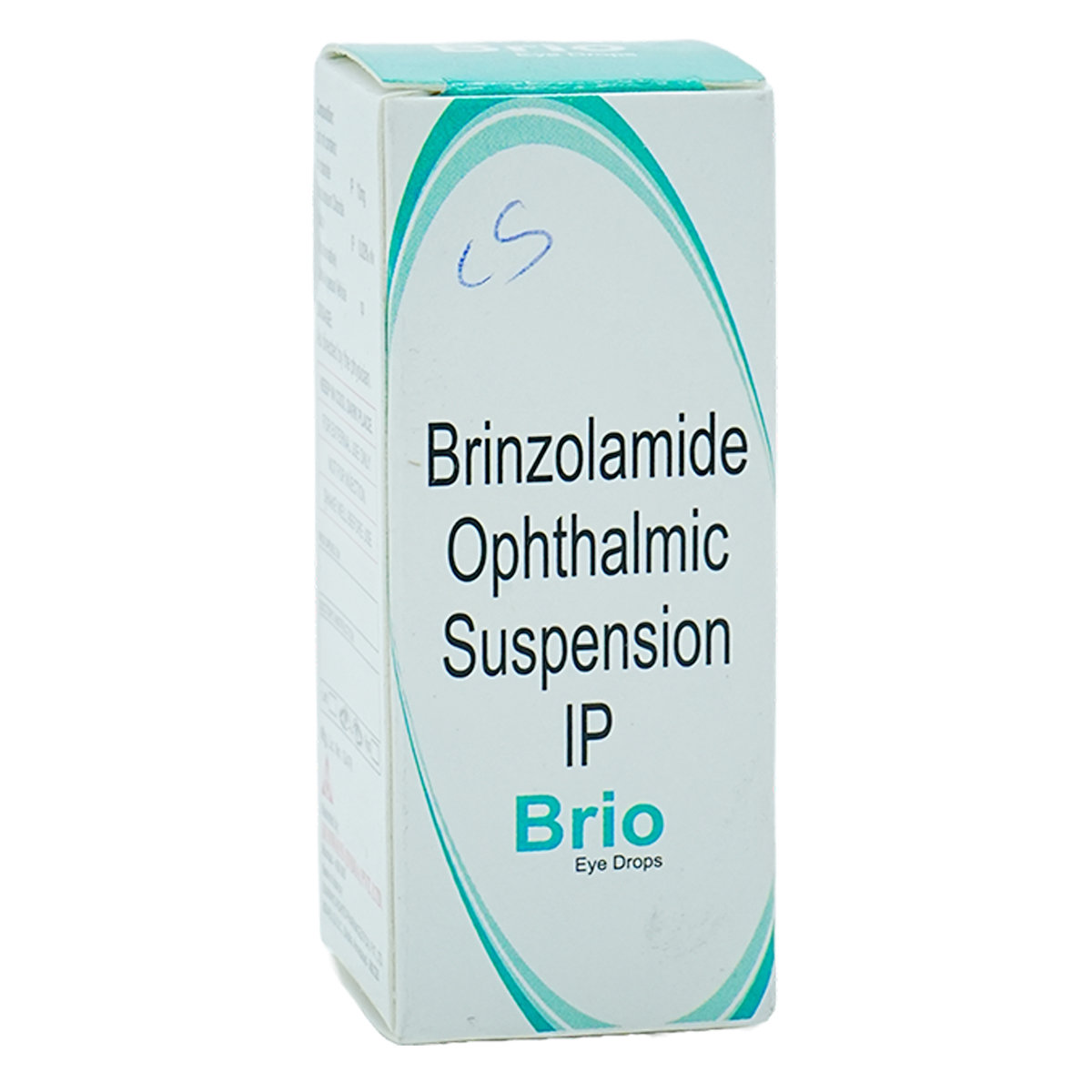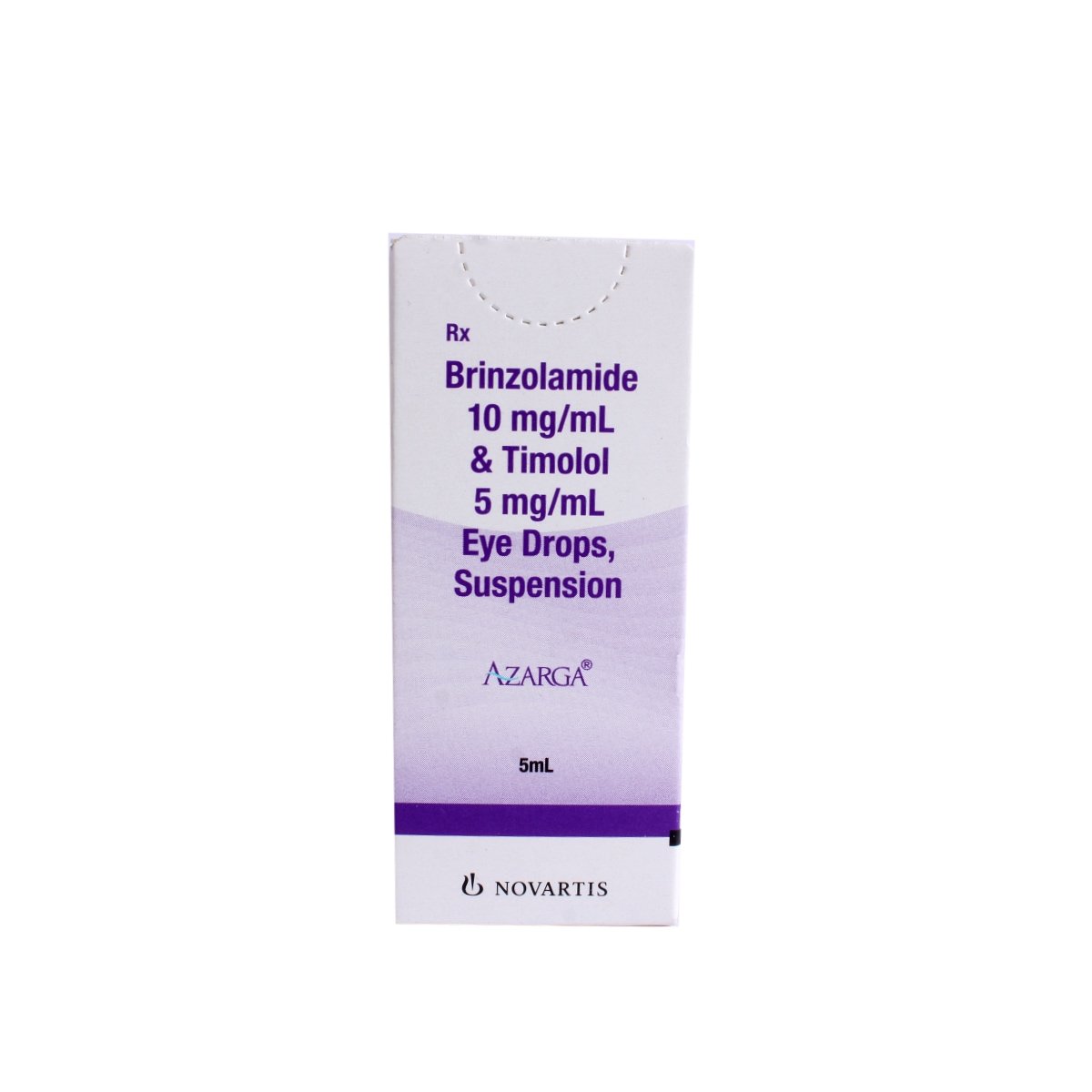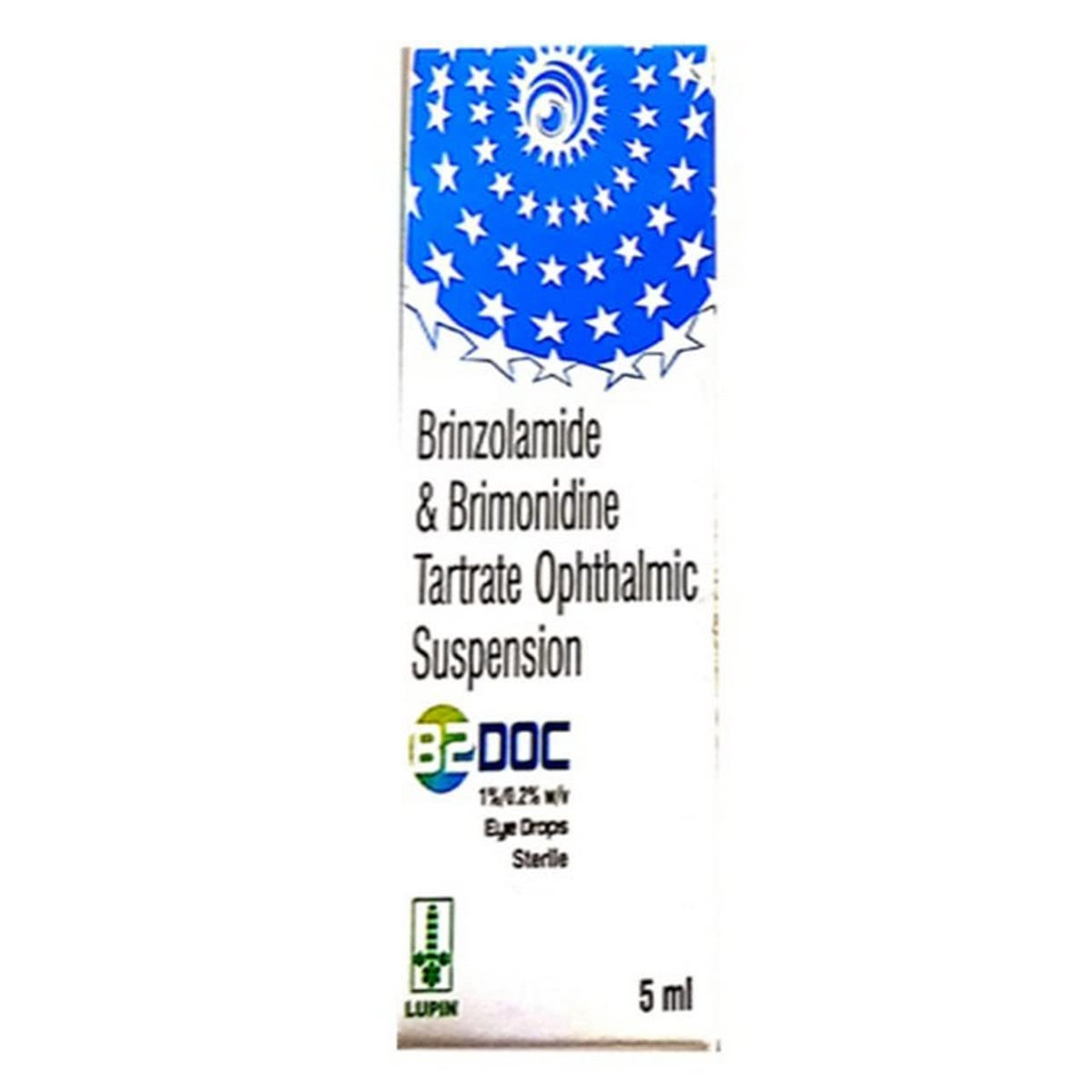Brinzolamide
About Brinzolamide
Brinzolamide belongs to a class of anti-glaucoma agents called carbonic anhydrase inhibitors primarily used to treat increased pressure in eye conditions. Glaucoma is an eye condition that causes damage to the optic nerve (essential for good vision) due to abnormally increased pressure in the eye. Ocular hypertension is increased pressure in the eye due to poor drainage of aqueous humour (fluid in the eye that maintains normal pressure by its continuous flow).
Brinzolamide contains Brinzolamide which works by inhibiting the action of carbonic anhydrase enzyme and decreasing bicarbonate production essential for the production of fluid in the eye (aqueous humour). Thus it reduces the secretion of eye fluid called 'aqueous humour' that maintains pressure in the eyeball and in turn lowers the raised pressure in the eye by reducing aqueous humour entry into the eyeball. Thus, Brinzolamide prevents eyes from getting blind in the conditions of open-angle type glaucoma and ocular hypertension.
Use Brinzolamide as prescribed. Brinzolamide is only for use in the eyes. Do not swallow or inject Brinzolamide. Your doctor will advise you on how many drops to instil based on your medical condition. In some cases, you may experience eye discharge, redness, itching, irritation or pain in the eyes, blurred vision, abnormal eye sensation and dry eyes. Most of these side effects of Brinzolamide do not require medical attention and gradually resolve over time. However, if the side effects worsen or persist, please consult your doctor.
If you are allergic to Brinzolamide or any other medicines, please tell your doctor. Brinzolamide is not recommended for children below 18 years of age. You are not advised to use Brinzolamide if you are pregnant, breastfeeding or have severe kidney problems or hyperchloraemic acidosis (excessive acidity in the blood). You are advised to remove soft contact lenses before using Brinzolamide as it may cause discolouration of the soft contact lens. If you get any new eye problem, an eye infection or notice any allergic reactions such as itching or redness of the eye and skin rash, please consult your doctor immediately. You are advised to maintain a 5 minutes time gap between using Brinzolamide and other eye drops. If you have dry eyes, cornea problems, narrow-angle glaucoma, pseudoexfoliative glaucoma or pigmentary glaucoma kidney or liver problems, before taking Brinzolamide.
Uses of Brinzolamide
Medicinal Benefits
Brinzolamide contains Brinzolamide used to treat increased pressure in the eye in conditions such as glaucoma (damage of optic nerve) and ocular hypertension (high fluid pressure inside the eye). Brinzolamide inhibits the action of carbonic anhydrase enzyme and decreases bicarbonate production that is essential for the production of aqueous humour. Thereby, it reduces the secretion of aqueous humour (a liquid that maintains normal pressure in the eyeball) and lowers the pressure in the eye by reducing aqueous humour entry into the eyeball.
Directions for Use
Storage
Side Effects of Brinzolamide
- Eye discharge
- Redness, itching, irritation or pain in the eyes
- Blurred vision
- Abnormal eye sensation
- Dry eyes
Drug Warnings
If you are allergic to Brinzolamide or any other medicines, please tell your doctor. Brinzolamide is not recommended for children below 18 years of age. You are not advised to use Brinzolamide if you are pregnant, breastfeeding, or have severe kidney problems or hyperchloraemic acidosis (excessive acidity in the blood). You are advised to remove soft contact lenses before using Brinzolamide as it may cause discoloration of the soft contact lens. If you get any new eye problem, an eye infection, or notice any allergic reactions such as itching or redness of the eye and skin rash, please consult your doctor immediately. You are advised to maintain a 5 minutes time gap between using Brinzolamide and other eye drops. Please do not touch the container tip to the eye, eyelids, or surrounding areas as it may contaminate Brinzolamide and cause eye infections. If you have dry eyes, cornea problems, narrow-angle glaucoma, pseudoexfoliative glaucoma, or pigmentary glaucoma kidney or liver problems, before taking Brinzolamide.
Drug Interactions
Drug-Drug Interaction: Brinzolamide may have interaction with medicines used to treat glaucoma (dorzolamide, acetazolamide).
Drug- Food Interaction: No interactions found.
Drug-Disease Interaction: If you have dry eyes, cornea problems, narrow-angle glaucoma, pseudoexfoliative glaucoma or pigmentary glaucoma kidney or liver problems, before taking Brinzolamide.
Drug-Drug Interactions Checker List:
Safety Advice

Alcohol
cautionThe interaction of alcohol with Brinzolamide is unknown. Please consult a doctor before consuming alcohol with Brinzolamide.

Pregnancy
unsafeBrinzolamide is a Category C pregnancy drug and is not recommended for use during pregnancy unless your doctor considers it essential.

Breast Feeding
unsafeAvoid breastfeeding while taking Brinzolamide. Please consult a doctor before using Brinzolamide in breastfeeding mothers.

Driving
cautionBrinzolamide may cause blurred vision in some people. So, drive only when your vision is clear after taking Brinzolamide.

Liver
cautionIf you have any concerns regarding the use of Brinzolamide in patients with liver problems, please consult a doctor.

Kidney
cautionIf you have any concerns regarding the use of Brinzolamide in patients with kidney problems, please consult a doctor.

Children
unsafeBrinzolamide is not recommended for children below 18 years of age, as the safety and effectiveness were not established.
Habit Forming
Diet & Lifestyle Advise
- Avoid baked foods such as cakes, cookies, donuts, or fried items such as French fries and stick margarine as these foods may worsen glaucoma and damage the optic nerve.
- Please cut down your coffee intake as it may increase pressure in the eye and replace coffee with green tea.
- Avoid exercises such as any position where the head is lower than the body like inverted yoga poses as it may increase pressure in the eye. Doing selective exercises is advised for glaucoma patients.
Special Advise
- You are recommended to avoid wearing contact lenses while using Brinzolamide as it may cause discoloration of soft contact lenses.
- Do not use Brinzolamide if you have used any steroid eye injection within six months, undergone any other intraocular surgery (like cataract surgery) within 6 months, or have had any laser surgery within 12 months.
Patients Concern
Disease/Condition Glossary
Glaucoma: It is an eye condition that causes damage to the optic nerve (essential for good vision) due to abnormally increased pressure in the eye. If it is not treated in time, it may cause blindness. Usually, there are no symptoms of glaucoma initially except the slow loss of vision gradually. However, some symptoms include visible rainbow-colored circles around bright lights or blurred vision. Rarely, glaucoma can develop suddenly with intense pain in the eye, visual disturbance, or nausea.
Ocular hypertension: It is a condition caused due to poor drainage of aqueous humor (fluid in the eye that maintains normal pressure by its continuous flow). This leads to the build-up of excess fluid in the eye resulting in increased pressure inside the eye without any damage to the optic nerve. If ocular hypertension is not controlled, it may lead to glaucoma.
FAQs
Brinzolamide contains Brinzolamide that works by inhibiting the action of carbonic anhydrase enzyme and decreases bicarbonate production that is essential for the production of aqueous humour. Thereby, it reduces the secretion of aqueous humour (a liquid that maintains normal pressure in the eyeball) and lowers the pressure in the eye by reducing aqueous humour entry into the eyeball.
You are recommended to wash your hands first and tilt your head back and gently pull the lower eyelid downwards. Then, press the bottom of the bottle gently by holding it upside down to instil one drop into the affected eye without touching the tip of the bottle to the eye or surrounding areas in order to avoid contamination. Finally, replace the cap tightly after use. After applying Brinzolamide, you are advised to apply to the corner of the eye by pressing a finger to stop eye drops from spreading into the rest of the body.
No, you are not recommended to wear contact lenses while using Brinzolamide as it contains benzalkonium chloride, a preservative that changes the colour of the contact lens as it may be absorbed by a soft contact lens. Benzalkonium chloride also causes irritation in the eye especially if you have disorders of the cornea (transparent layer at the front of the eye) or dry eyes. Therefore, you are advised to remove contact lenses before applying Brinzolamide and reinsert after 15 minutes of using Brinzolamide. Also, inform your doctor if you experience pain, stinging or abnormal sensation in the eye after using Brinzolamide.
You are recommended to maintain a minimum of 5 minutes time gap between using Brinzolamide and other eye drops and administer eye ointments in the last.
Yes, Brinzolamide may cause temporary blurred vision. Therefore, you are recommended to wait until your vision is clear before driving or operating heavy machinery.
You are not recommended to stop using Brinzolamide without consulting your doctor as it may increase pressure in the eyes and may lead to loss of vision. Therefore, use Brinzolamide for as long as your doctor has prescribed it, and if you experience any difficulty while taking Brinzolamide, please consult your doctor.








